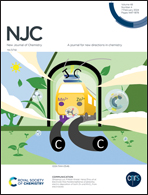Synthesis and iodine-trapping properties of novel nitrogen-rich imide covalent organic framework materials
Abstract
The exploration of efficient materials for capturing radioactive iodine in nuclear waste is of great significance to the development of nuclear energy and the protection of ecological environment. Nitrogen-rich imide covalent organic framework materials (COFs) have attracted much attention because of their excellent ability to adsorb radioactive iodine, but the harsh synthesis conditions limit their application in the adsorption neighborhood. In this paper, a simple and mild synthesis method was used to synthesize a covalent organic framework material (TFPT–Pa COF) connected by imine bonds at room temperature. The existence of electron-rich N atoms and the π–π conjugated structure make the TFPT–Pa COF material exhibit excellent iodine enrichment performance, and the enrichment capacity of iodine vapor is 3.67 g g−1. The adsorption is mainly chemisorption. For the adsorption of iodine in cyclohexane solution, the maximum adsorption equilibrium capacity reached 1407 mg g−1, which was more consistent with the Langmuir model, indicating that the adsorption process was dominated by monolayer adsorption. After absorbing iodine vapor, the material can be desorbed quickly in ethanol and exhibits good reusability performance.



 Please wait while we load your content...
Please wait while we load your content...